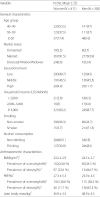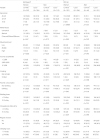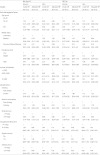1. Keeffe EB, Adesman PW, Stenzel P, Palmer RM. Steatosis and cirrhosis in an obese diabetic. Dig Dis Sci. 1987; 32(4):441–445. DOI:
10.1007/BF01296300. PMID:
3829884.
2. Ng M, Fleming T, Robinson M, Thomson B, Graetz N, Margono C, Mullany EC, Biryukov S, Abbafati C, Abera SF, et al. Global, regional, and national prevalence of overweight and obesity in children and adults during 1980–2013: a systematic analysis for the Global Burden of Disease Study 2013. Lancet. 2014;384(9945):766–81.
3. Wang Y, Beydoun MA. The obesity epidemic in the United States--gender, age, socioeconomic, racial/ethnic, and geographic characteristics: a systematic review and meta-regression analysis. Epidemiol Rev. 2007; 29:6–28. DOI:
10.1093/epirev/mxm007. PMID:
17510091.
4. Stevens GA, Singh GM, Lu Y, Danaei G, Lin JK, Finucane MM, Bahalim AN, McIntire RK, Gutierrez HR, Cowan M, et al. National, regional, and global trends in adult overweight and obesity prevalences. Popul Health Metr. 2012;10(1):22.
5. Finucane MM, Stevens GA, Cowan MJ, Danaei G, Lin JK, Paciorek CJ, Singh GM, Gutierrez HR, Lu Y, Bahalim AN, et al. National, regional, and global trends in body-mass index since 1980: systematic analysis of health examination surveys and epidemiological studies with 960 country-years and 9.1 million participants. Lancet. 2011;377(9765):557–67.
6. Kim HJ, Kim Y, Cho Y, Jun B, Oh KW. Trends in the prevalence of major cardiovascular disease risk factors among Korean adults: results from the Korea National Health and Nutrition Examination Survey, 1998–2012. Int J Cardiol. 2014; 174(1):64–72. DOI:
10.1016/j.ijcard.2014.03.163. PMID:
24742812.
7. Flegal KM, Carroll MD, Ogden CL, Johnson CL. Prevalence and trends in obesity among US adults, 1999–2000. JAMA. 2002; 288(14):1723–1727. DOI:
10.1001/jama.288.14.1723. PMID:
12365955.
8. Martinez JA, Kearney JM, Kafatos A, Paquet S, Martínez-Gonzélez MA. Variables independently associated with self-reported obesity in the European Union. Public Health Nutr. 1999; 2(1a):125–133. DOI:
10.1017/S1368980099000178. PMID:
10933632.
9. Duvigneaud N, Wijndaele K, Matton L, Deriemaeker P, Philippaerts R, Lefevre J, Thomis M, Duquet W. Socio-economic and lifestyle factors associated with overweight in Flemish adult men and women. BMC Public Health. 2007;7(1):23.
10. Di Milia L, Mummery K. The association between job related factors, short sleep and obesity. Ind Health. 2009;47(4):363–8.
11. Extracts OS. Average annual hours actually worked per worker. In. Edited by Development OfECa; 2010.
12. Lallukka T, Sarlio-Lahteenkorva S, Kaila-Kangas L, Pitkaniemi J, Luukkonen R, Leino-Arjas P. Working conditions and weight gain: a 28-year follow-up study of industrial employees. Eur J Epidemiol. 2008; 23(4):303–310. DOI:
10.1007/s10654-008-9233-7. PMID:
18322807.
13. Ko GT, Chan JC, Chan AW, Wong PT, Hui SS, Tong SD, Ng SM, Chow F, Chan CL. Association between sleeping hours, working hours and obesity in Hong Kong Chinese: the ‘better health for better Hong Kong‘health promotion campaign. Int J Obes (2005). 2007;31(2):254–60.
14. Ostry AS, Radi S, Louie AM, LaMontagne AD. Psychosocial and other working conditions in relation to body mass index in a representative sample of Australian workers. BMC Public Health. 2006; 6:53. DOI:
10.1186/1471-2458-6-53. PMID:
16512915.
15. Kong M-H. Economic Development and Women’s Status in Korea. Contemp South Korean Soc. 2013; 26:41.
16. Gynaecol ANZJO. 1. WHO: Obesity: preventing and managing the global epidemic. Report of a WHO consultation. World Health Organ Tech Rep Ser. 2000; 894:1–253.
17. Flegal KM, Carroll MD, Kuczmarski RJ, Johnson CL. Overweight and obesity in the United States: prevalence and trends, 1960–1994. Int J Obes Relat Metab Disord. 1998; 22(1):39–47. DOI:
10.1038/sj.ijo.0800541. PMID:
9481598.
18. Mokdad AH, Bowman BA, Ford ES, Vinicor F, Marks JS, Koplan JP. The continuing epidemics of obesity and diabetes in the United States. Jama. 2001; 286(10):1195–1200. DOI:
10.1001/jama.286.10.1195. PMID:
11559264.
19. Kuskowska-Wolk A, Rössner S. Body mass distribution of a representative adult population in Sweden. Diabetes Res Clin Pract. 1990; 10:S37–S41. DOI:
10.1016/0168-8227(90)90138-J. PMID:
2286149.
20. Hedley AA, Ogden CL, Johnson CL, Carroll MD, Curtin LR, Flegal KM. Prevalence of overweight and obesity among US children, adolescents, and adults, 1999–2002. JAMA. 2004; 291(23):2847–2850. DOI:
10.1001/jama.291.23.2847. PMID:
15199035.
21. Haarbo J, Marslew U, Gotfredsen A, Christiansen C. Postmenopausal hormone replacement therapy prevents central distribution of body fat after menopause. Metabolism. 1991; 40(12):1323–1326. DOI:
10.1016/0026-0495(91)90037-W. PMID:
1961129.
22. Godsland I, Wynn V, Crook D, Miller N. Sex, plasma lipoproteins, and atherosclerosis: prevailing assumptions and outstanding questions. Am Heart J. 1987; 114(6):1467–1503. DOI:
10.1016/0002-8703(87)90552-7. PMID:
3318361.
23. Iwao S, Iwao N, Muller DC, Elahi D, Shimokata H, Andres R. Effect of aging on the relationship between multiple risk factors and waist circumference. J Am Geriatr Soc. 2000; 48(7):788–794. DOI:
10.1111/j.1532-5415.2000.tb04754.x. PMID:
10894318.
24. Trémollieres FA, Pouilles J-M, Ribot CA. Relative influence of age and menopause on total and regional body composition changes in postmenopausal women. Am J Obstet Gynecol. 1996; 175(6):1594–1600. DOI:
10.1016/S0002-9378(96)70111-4. PMID:
8987946.
25. Boynton A, Neuhouser ML, Sorensen B, McTiernan A, Ulrich CM. Predictors of diet quality among overweight and obese postmenopausal women. J Am Diet Assoc. 2008; 108(1):125–130. DOI:
10.1016/j.jada.2007.10.037. PMID:
18155998.
27. McTiernan A, Wu L, Chen C, Chlebowski R, Mossavar‐Rahmani Y, Modugno F, Perri MG, Stanczyk FZ, Horn L, Wang C. Relation of BMI and physical activity to sex hormones in postmenopausal women. Obesity. 2006;14(9):1662–77.
28. Jang T-W, Kim H-R, Lee H-E, Myong J-P, Koo J-W. Long work hours and obesity in Korean adult workers. J Occup Health. 2013; 55(5):359–366. DOI:
10.1539/joh.13-0043-OA. PMID:
23892643.
29. Porter JS, Bean MK, Gerke CK, Stern M. Psychosocial factors and perspectives on weight gain and barriers to weight loss among adolescents enrolled in obesity treatment. J Clin Psychol Med Settings. 2010; 17(2):98–102. DOI:
10.1007/s10880-010-9186-3. PMID:
20119710.
30. Chrousos G. The role of stress and the hypothalamic-pituitary-adrenal axis in the pathogenesis of the metabolic syndrome: neuro-endocrine and target tissue-related causes. Int J Obes Relat Metab Disord. 2000; 24:S50–55. DOI:
10.1038/sj.ijo.0801278. PMID:
10997609.
31. Chaput JP, Després JP, Bouchard C, Tremblay A. Short sleep duration is associated with reduced leptin levels and increased adiposity: results from the Quebec family study. Obesity. 2007; 15(1):253–261. DOI:
10.1038/oby.2007.512. PMID:
17228054.
32. Forbes S, Bui S, Robinson BR, Hochgeschwender U, Brennan MB. Integrated control of appetite and fat metabolism by the leptin-proopiomelanocortin pathway. Proc Natl Acad Sci. 2001; 98(7):4233–4237. DOI:
10.1073/pnas.071054298. PMID:
11259669.
34. Virtanen M, Ferrie JE, Singh-Manoux A, Shipley MJ, Stansfeld SA, Marmot MG, Ahola K, Vahtera J, Kivimäki M. Long working hours and symptoms of anxiety and depression: a 5-year follow-up of the Whitehall II study. Psychol Med. 2011;41(12):2485–94.
35. Maruyama S, Morimoto K. Effects of long workhours on life-style, stress and quality of life among intermediate Japanese managers. Scand J Work Environ Health. 1996; 22:353–359. DOI:
10.5271/sjweh.153. PMID:
8923608.
36. Calle EE, Kaaks R. Overweight, obesity and cancer: epidemiological evidence and proposed mechanisms. Nat Rev Cancer. 2004; 4(8):579–591. DOI:
10.1038/nrc1408. PMID:
15286738.
37. James PT, Leach R, Kalamara E, Shayeghi M. The worldwide obesity epidemic. Obes Res. 2001; 9(S11):228S–233S. DOI:
10.1038/oby.2001.123. PMID:
11707546.
38. Kang S-J, Song Y, Kim D-Y, Kim S-H, Park J-H. Validation of Bioelectrical Impedance Analyzer for Measuring Percentage of Body Fat. Fort Worth, Texas: 2008 AAHPERD National Convention and Exposition: 2008. 2008.









